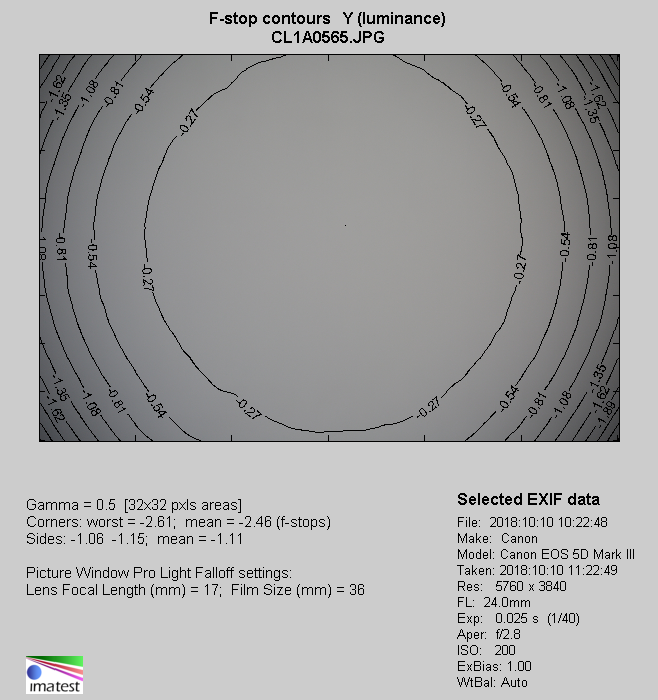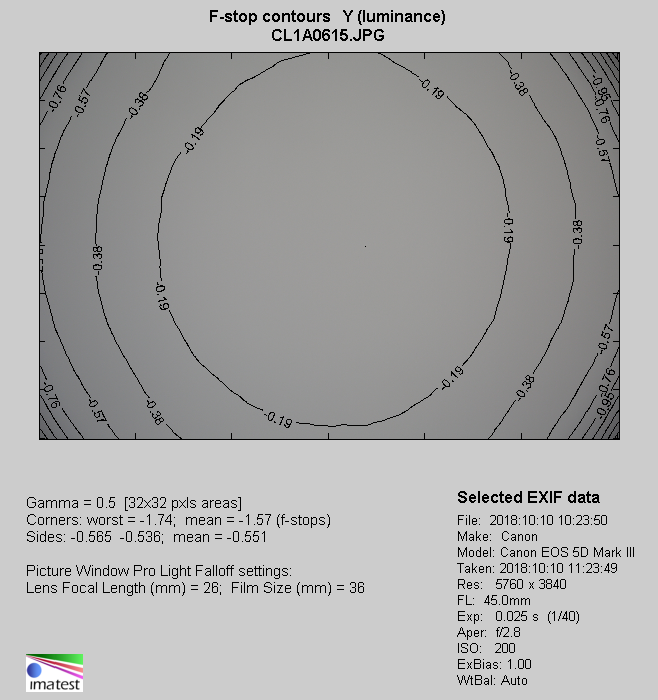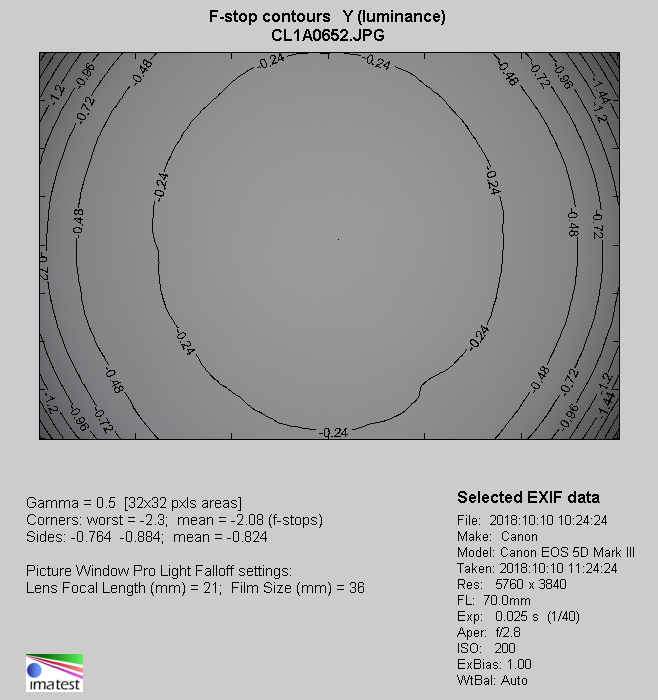Tamron SP 24-70 mm f/2.8 VC USD G2
8. Vignetting
| Canon 50D, 24ámm, f/2.8 | Canon 50D, 24ámm, f/4.0 |

|

|
| Canon 50D, 45ámm, f/2.8 | Canon 50D, 45ámm, f/4.0 |

|

|
| Canon 50D, 70ámm, f/2.8 | Canon 50D, 70ámm, f/4.0 |

|

|
At the shortest focal length and with the lens wide open the brightness loss in the frame corners amounts to just 13% (−0.40 EV) and it becomes imperceptible after stopping down the aperture by 1 EV. In the middle of the focal range the situation is even better because it is hard to notice any vignetting at the maximum relative aperture – it is just 10% (−0.32 EV). On stopping down the lens to f/4.0 the light fall off decreases to 8% (−0.25 EV). A similar effect can be observed at 70 mm – results we got by f/2.8 and f/4.0 are, respectively, 12% (−0.37 EV), and 7% (−0.21 EV).
Please Support UsIf you enjoy our reviews and articles, and you want us to continue our work please, support our website by donating through PayPal. The funds are going to be used for paying our editorial team, renting servers, and equipping our testing studio; only that way we will be able to continue providing you interesting content for free. |
- - - - - - - - - - - - - - - - - - - - - - - - - - - - - - - - - - - - - - - - - - - - - - - -
Let’s progress to vignetting on full frame – below you can find images taken with the Canon 5D Mark III.
| Canon 5DáIII, 24ámm, f/2.8 | Canon 5DáIII, 24ámm, f/4.0 |

|

|
| Canon 5DáIII, 45ámm, f/2.8 | Canon 5DáIII, 45ámm, f/4.0 |

|

|
| Canon 5DáIII, 70ámm, f/2.8 | Canon 5DáIII, 70ámm, f/4.0 |

|

|
A difficult combination of the 24 mm focal length and f/2.8 aperture makes itself felt – you have to take into account light fall off amounting to 57% (−2.46 EV) in frame corners. Exactly the same result had the Sigma; it is, at the same time, a value higher than that of the stabilized Nikkor, slightly worse than that of the Tokina but better than the result of the Canon.
The vignetting of the Tamron decreases quite slowly on stopping down. Results we got by f/4.0, f/5.6, f/8.0 and f/11.0 apertures are, respectively: 41% (−1.49 EV), 31% (−1.07 EV), 29% (−0.99 EV) and again 29% (−0.99 EV). In the middle of the focal range the vignetting level is lower, amounting at the maximum relative aperture to 42% (−1.57 EV). On stopping down to f/4.0 it decreases to 24% (−0.78 EV), and after further stopping down to f/5.6 and f/8.0 it drops to 18% (−0.57 EV) and 17% (−0.54 EV) respectively.
At the maximum focal length serious vignetting problems return – by f/2.8 the light fall off reaches 51% (−2.08 EV) and it is, next to that of the Sigma, the worst result of all group. By f/4.0 the aberration decreases to 31% (−1.05 EV), and by f/5.6 it is 23% (−0.76 EV). By f/8.0 and f/11.0 apertures the brightness loss amounts to just 17% (−0.53 EV) and 14% (−0.42 EV).
| Canon 5DáMkáIII, 24ámm, f/2.8 |
 |
| Canon 5DáMkáIII, 45ámm, f/2.8 |
 |
| Canon 5DáMkáIII, 70ámm, f/2.8 |
 |






